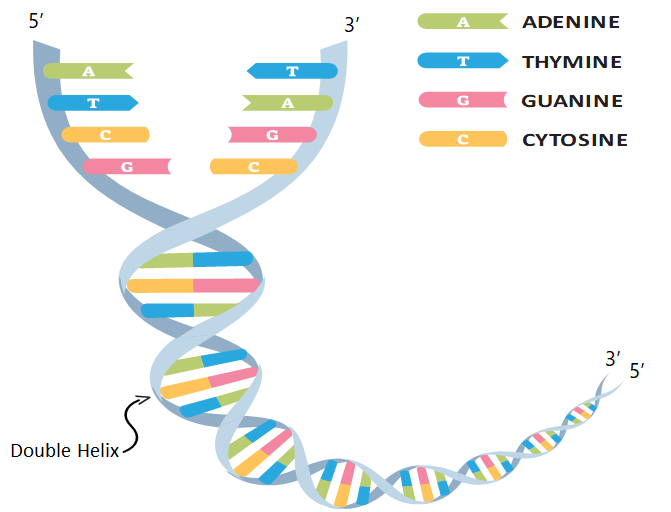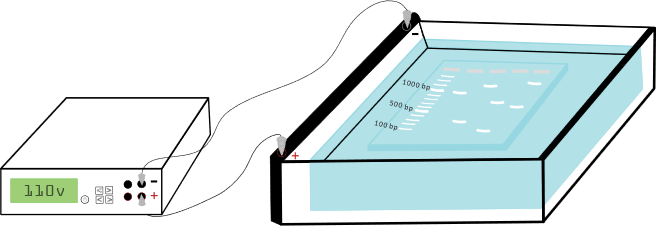DNA is an abbreviation for deoxyribonucleic acid. This is the genetic material inside our cells. DNA is like a flexible ladder made of two strands of threads laid out in opposite direction with the rungs in the middle being made of 4 different bases (compounds that are basic instead of acidic and made up of nitrogen containing simple ring structures). For now, we will call these bases as letters A, T, G and C. The steps in the ladder are always made by pairing A with T and G with C as shown in the Figure shown below.

So, it is referred to as a base pair (bp) to indicate the double strands of the ladder. As the ladder is flexible, it ends up forming a twisted ladder or a helix. Since it has two opposite going strands (going 5’ to 3’ in either direction), it is called a double helix. This double helical DNA is the way our genetic material is arranged inside our cells as 23 pairs of chromosomes. For each pair of chromosomes, one came from each of our parents. By the way, the letters are code for bases as A stands for the base Adenine, T stands for Thymine, G stands for Guanine and C stands for cytosine. The ladder backbone of DNA we talked about earlier is made of sugars called deoxyribose and the bases A, T, G and C are attached to these sugars. Scientists call these as deoxy nucleotides or simply nucleotides. To be specific, A is called deoxy adenine triphosphate (dATP) and, T is called deoxy thymine triphosphate (dTTP), G is called deoxy guanine triphosphate (dGTP) and C is called deoxy cytosine triphosphate (dTTP). For convenience, we will refer to them as A, T, G and C. As mentioned before, since A can attach to T and G can attach to C, two strands with the right arrangement of bases and going in the opposite direction can always come together and that is how they form the double helical form of DNA. Since DNA has two strands, a piece of DNA that is 100 bases long in one direction is also 100 bases long in the other direction. Because of this, scientists tend to say that it is 100 base pairs (bp) long. When casually mentioned that a gene is 100 or 1000 bases long, it really means base pairs (bp) unless someone specifically says that they are talking about one strand. It may be worth pointing out here that the two strands of DNA can be completely separated into single strands by heating a tube of DNA to a temperature close to 100°C. If you cool the tube, the two strands that are complementary will find itself and come back and form the original molecule. This property of DNA is unique. Another notable property of DNA is that it has a charge – it is negatively charged. Therefore, if you put DNA in a gel (gelatinous matrix) or a solution and pass electric current, the DNA will always move to the positive pole (+ of a battery). So, you can separate DNA from other things in a cell by using this negative charge of the DNA. This feature of DNA is used to figure out the size of DNA by putting DNA in a gelatinous media called a gel and passing electric current. If there are different molecules of DNA of varying sizes that are also negatively charged, this feature can be used to separate DNA based on size as shown below in Figure 2. Smaller pieces will move faster through the gel compared to larger pieces of DNA.

As shown in the illustration above, a power supply provides a certain voltage to run through the gel separating the DNA after a few minutes. In the gel shown on the right of the illustration, the first lane shows what is known as a DNA ladder of known sizes. A few pieces of DNA of known sizes are indicated as 100 bp (base pairs), 500 bp and 1000 bp etc. to show the size of the bands in the other lanes.